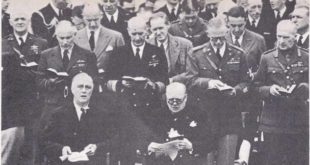Even before Pearl Harbour, there had been cooperation between the United States and Britain. In August of 1941, President Roosevelt and Prime Minister Churchill met secretly, on a cruiser at sea off the coast of Newfoundland. There they drew up the Atlantic Charter, a document stating the principles on which they based their hopes for a better future for the world. They pledged that neither country would seek more territory. They hoped that, “after the final destruction of Nazi tyranny,” all men in all lands could “live out their lives in freedom from want and fear,” and they called on all nations to give up the use of force and disarm. With the United States in the war, the cooperation among the nations fighting the Axis powers became still closer. There were meetings between the heads of the nations and their representatives — the first of many that would take place throughout the war. Out of the early meetings came an important decision. All possible strength must be thrown against Germany, for once Germany was defeated, Japan would surely fall. On January 1, 1942, all twenty-six nations fighting the Axis signed a pact. Calling themselves the United Nations, they agreed to abide by the Atlantic Charter and not to make a separate peace with the enemy. As the year began, the Germans started an offensive in Africa. General Rommel and his Afrika Korps won back El Agheila, which the British had taken the previous April. By the end of June, 1942, the British had lost 80,000 men and had been forced to retreat 400 miles to El Alamein, in Egypt. This was only 60 miles from the city of Alexandria and there was danger that Rommel would cut off the Suez Canal. Rommel could not take El Alamein. The British …
Read More »Russia Under the Tsars 1462-1796
IN THE LAST PART of the fifteenth century, the monks and courtiers of Moscow began to say that Moscow was destined to become the “Third Rome.” The first Rome, they said had been great as the centre of Christianity; but when the Romans had recognized the pope, Rome had been punished by destruction. The second Rome had been Constantinople, the centre of the Orthodox Church; but Constantinople, too, had briefly recognized the pope, and it, too, had fallen. Now Moscow, where the Orthodox faith still remained pure, was to become the Third Rome — the great centre of the Christian world. It would remain so, “for two Romes have fallen, the third stands and a fourth will not be.” Once Moscow had been small and unimportant, but the dukes of Moscow had been bold and ambitious, seizing every opportunity to make Moscow stronger. Sometimes they acted more like thieves than princes. Grand Duke Daniel once invited another prince to dinner, pretending friendship. When the guest arrived, Daniel threw him into prison and seized his lands. Daniel’s son, Ivan, who was called Ivan Moneybags, made Moscow the home of the Metropolitan, the head of the Russian Orthodox Church. Ivan Moneybags also became the tax collector for the Tatar overlords and he kept a good part of the taxes, for himself. Other dukes stole or bought or conquered new lands to make Moscow greater. THE BOYARS So, when Ivan III became Grand Duke in 1462, he inherited one of the most powerful kingdoms of Russia. Ivan acted very much as though he believed the story of the Third Rome. He married Sophia, niece of the last Byzantine emperor. He put the two-headed eagle of Rome on his own state seal. He sometimes even called himself tsar, which was the Russian way of …
Read More »The Ottomans, the Last Great Islamic Power A.D. 1299-1922
ACCORDING to their tradition, the Ottoman Turks once belonged to the same Central Asian tribe as the Seljuk Turks. Their ancestors came to Asia Minor with the Seljuks. In time, they began to challenge the authority of their fellow Turks. The Ottomans took their name from a chieftain called Othman, who in 1299 became the emir of Seljuk lands bordering on the Byzantine Empire. Othman declared holy war on his Christian neighbours. His son Orkhan captured the city of Brusa and in 1362 Orkhan’s son Murad took Adrianople, beyond the strait and sea that separated Asia Minor from Europe. Thereafter, Murad and his son Bayezid pressed forward on two fronts–against Serbs, Bulgars and other Balkan peoples in southeast Europe and against Byzantines and Seljuks in Asia Minor. By 1400, the Ottomans had conquered Macedonia and Bulgaria, pushed the Byzantines out of Asia Minor and swept the Seljuk emirs from their thrones. In that year, however, Timur attacked the eastern Bank of their kingdom. After devastating Syria, he came back and crushed the Ottoman army near Ankara, taking Sultan Bayezid captive. He restored the Seljuk emirs to their posts. When Bayezid died in 1405, his three sons immediately began to fight over their inheritance. Their struggle raged for ten years. At last Sultan Mohammed came out the winner, with both of his brothers dead. These civil wars, coming so soon after the Mongol invasion, left the land and the people exhausted. The Ottomans’ fighting spirit soon revived. Under Mohammed and his son Murad II, Turkish armies again advanced across southeast Europe. In 1443, a huge army made up of Rumanians, Hungarians, Poles, Germans and Frenchmen defeated them. Five years later, however, they beat back another massive Christian attack in Serbia. Murad’s son Mohammed II, became sultan in Adrianople in 1451. He …
Read More »


